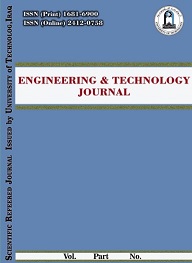Abstract
Hydrogen embrittlement is a diffusible Hydrogen that is harmful to the toughness of iron. It follows, therefore, that the harmful influence of diffusible Hydrogen can be mitigated by preventing its entry into steel. This approach was achieved by using three coating layers as a coating nanostructure thin layer by DC
sputtering on steel structural (AISI l018) and hydrogen charging (HC) effect on
uncoated and different Nano coated tensile specimens. The first layer was
Titanium as a bonding layer, the second layer was TiO2 with Al2O3, and the third
layer was Al2O3. Using a titanium Nano layer coating on AISI1018 steel tensile
specimens increased the tensile strength from 570 to 659 MPa with 16 hours of
charging, which is considered a good increase. In contrast, the elongation
remained in a steady-state with little difference in values compared to changing
the charging time and the coating of the double layer. Furthermore, it was found
that samples coated with TiO2 and Al2O3 by the DC method had advanced
hydrogen embrittlement resistance and increased tensile strength (from 565 to
680 MPa with 8 hours of charging process). Moreover, the maximum adhesion
value was related to the triple layer at 596 psi, and the lowest value was 309 psi
using the titanium layer alone. The coating time was 5 hours of the sputtering
process for all specimens. The coating layers are considered a good barrier for
hydrogen permeation through steel structures (AISI 1018).
sputtering on steel structural (AISI l018) and hydrogen charging (HC) effect on
uncoated and different Nano coated tensile specimens. The first layer was
Titanium as a bonding layer, the second layer was TiO2 with Al2O3, and the third
layer was Al2O3. Using a titanium Nano layer coating on AISI1018 steel tensile
specimens increased the tensile strength from 570 to 659 MPa with 16 hours of
charging, which is considered a good increase. In contrast, the elongation
remained in a steady-state with little difference in values compared to changing
the charging time and the coating of the double layer. Furthermore, it was found
that samples coated with TiO2 and Al2O3 by the DC method had advanced
hydrogen embrittlement resistance and increased tensile strength (from 565 to
680 MPa with 8 hours of charging process). Moreover, the maximum adhesion
value was related to the triple layer at 596 psi, and the lowest value was 309 psi
using the titanium layer alone. The coating time was 5 hours of the sputtering
process for all specimens. The coating layers are considered a good barrier for
hydrogen permeation through steel structures (AISI 1018).
